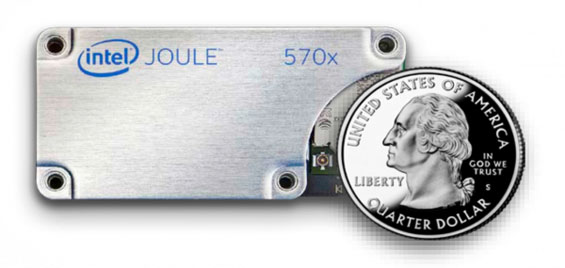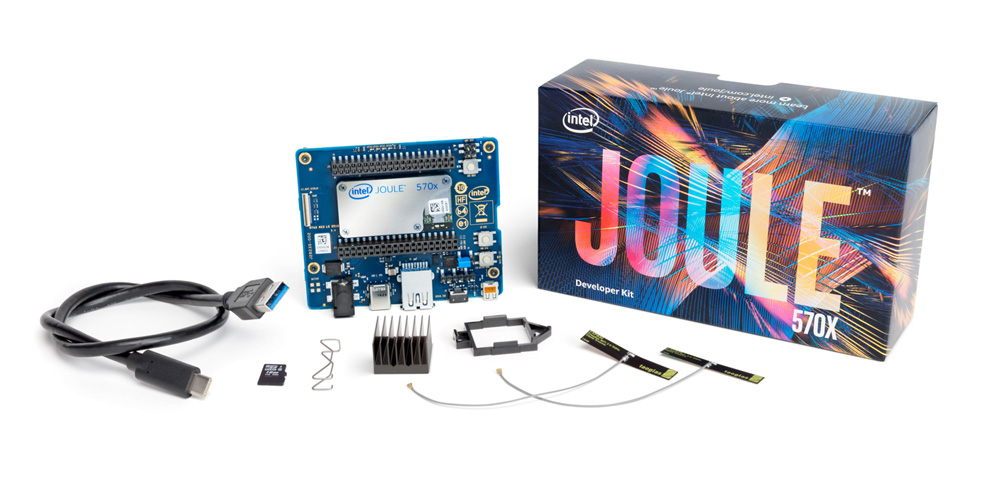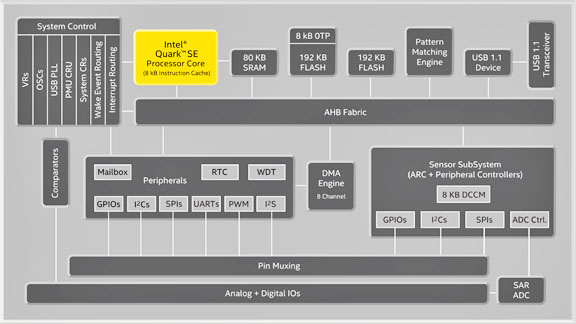By Jim Harrison
I spent a good amount of time at Intel’s IDF2016 this week. Found a number of interesting items at partner booths on the “Technology Showcase” floor and have already written about a few Intel items. But, there are two more announcements from Intel worth taking a look at.
The Joule compute module
Among the products introduced by Intel at IDF2016 was the Joule compute module, an Atom processor based platform. The small card targets IoT projects, robots, home and industrial automation. Intel thinks makers, entrepreneurs, and established enterprises will be will be especially interested. I could not get a price for the modules, a really important factor that Intel chooses not to disclose, but the top end development kit sells for $369.
The top end version of the module uses a 64-bit, 1.7 GHz quad-core Atom T5700 processor and includes 4K video, 4 Gbytes of LPDDR4 RAM, 16 Gbytes of eMMC memory, and support for Intel’s RealSense depth-sensing camera. Engineers can choose from multiple operating systems and take advantage of off-the-shelf libraries and sensors. The module also has 802.11ac Wi-Fi, Bluetooth 4.1, and USB 3.0 ports.

Intel recently decided not to push Atom CPUs for portable consumer items like smartphones, tablets, laptops and instead is going to suggest using its Celeron and Pentium processors in mobile. They discontinued a number of versions of the Atom CPU. Now Atom seems firmly targeted at embedded.
Joule is the fastest of Intel’s compute modules, including Galileo Gen2, Edison, and the tiny Curie system that targets wearables. The Joule module should offer plenty of performance. Intel says the small card is well suited for “products and industrial systems requiring advanced computer vision or high-end edge computing.”

Developer kits are on a different sized board than the modules, though it looks like they have a module plugged into them. The Joule 570x developer kit is available immediately through distribution. Part number GT.PDKW. Intel Joule 570x and 550x platforms, as well as the Joule 550x developer kit, will be available in Q4 2016. These modules will not have long term availability, but they can be transitioned to a manufacturing partner very easily.
The newest Quark microcontroller
One more thing I don’t want you to forget about – The Intel Quark microcontroller comes in a new version called the SE C1000. It includes a pattern matching engine that allows it to learn and differentiate, along with a sensor interface subsystem and power management that reduces consumption through programmable wake cues enabling always-sensing intelligence. This pattern matching may be extremely interesting in some applications.

The chips sensor subsystem has an ARC EM4 DSP with floating point extensions, an 8 Kbyte L1 instruction cache, 8 Kbyte data CCM and a tightly coupled I/O to interface, a serial interface, and a 12-bit A/D. It looks like it is priced at $12 ea/100.
Intel says pattern matching technology: allows the microcontroller to learn through pattern recognition and differentiate appropriate response events. Having decision-making ability at the edge, rather than someplace in the cloud, can provide a much more real-time response.
The Quark SE has an 8 Kbyte cache 80 Kytes of SRAM, 384 Kbytes of flash, and an 8 Kbyte OTP. It works from a 1.8 to 3.3 V supply at a nice leisurely 32 MHz clock speed. The device is optimized low power battery operation. It takes only 250 µA in sensing standby mode and
Advertisement
Learn more about Intel





